By studying the molecular machinery of protein recycling, the research will open new avenues for cancer research
Assistant Professor Jianhua Zhao, PhD, has been awarded a unique and competitive grant from the National Institute of General Medical Sciences (NIGMS), part of the National Institutes of Health (NIH). The five-year, $2.4 million grant aims to give researchers greater research flexibility to work on fundamental questions in biology.
“This award alleviates the need to be constantly writing new grants, which gives us more time and space to get to the actual research,” says Zhao. “This is an emerging funding model that has recently been gaining a lot of popularity.”
The grant was awarded as part of NIGMS’ MIRA program, which stands for Maximizing Investigators’ Research Award. While most grants from the NIH fund individual projects, with specific outcomes specified for each grant, this new funding program distributes funds to researchers to fund several ongoing projects simultaneously.
“Science is never linear,” says Zhao. “The results of one experiment always inspire new questions, and having this grant lets us follow those threads as they emerge.”
Zhao’s research focuses on proteolysis, the process cells use to break down and recycle unused proteins. Proteolysis is essential for normal cell replication because our cells use the by-products of this process to know when it’s time to replicate. Because cancer occurs when cellular replication spirals out of control, proteolysis is also an important process for cancer cells.
“Interrupting protein recycling is already an established therapeutic strategy for some cancers, like multiply myeloma,” says Zhao. “Our goal with this grant is to learn more about the fundamental biology of this process and the structures that control it so we can open up new avenues for cancer treatment.”
To study the molecular machinery of proteolysis, Zhao and his team will use a cutting-edge imaging approach on proteosomes, the multi-protein structures that control proteolysis. The method, called Cryogenic electron microscopy (Cryo-EM), works by lowering samples to extremely cold temperatures, making it easier to generate atomic-resolution images of biological molecules.
“Cryo-EM is extremely high-resolution, much more so than other imaging methods,” says Zhao. “Being able to use it on biomolecules is a major leap forward in methodology that’s changing the landscape of structural biology.”
Another benefit of the approach is that it requires very little of the sample, which means it can be used to study proteins that are present in very small amounts in our cells.
“This is important because it gets us closer to seeing how biological molecules actually look when they’re in our cells,” says Zhao. “We’re excited to unlock the potential of this method and leverage it against cancer.”
The grant, awarded by the National Institute of General Medical Sciences of the National Institutes of Health, is titled, “Molecular Mechanisms Underlying the Assembly of The Human Proteasome and Endogenous Protein Complexes” (R35 GM147487).
